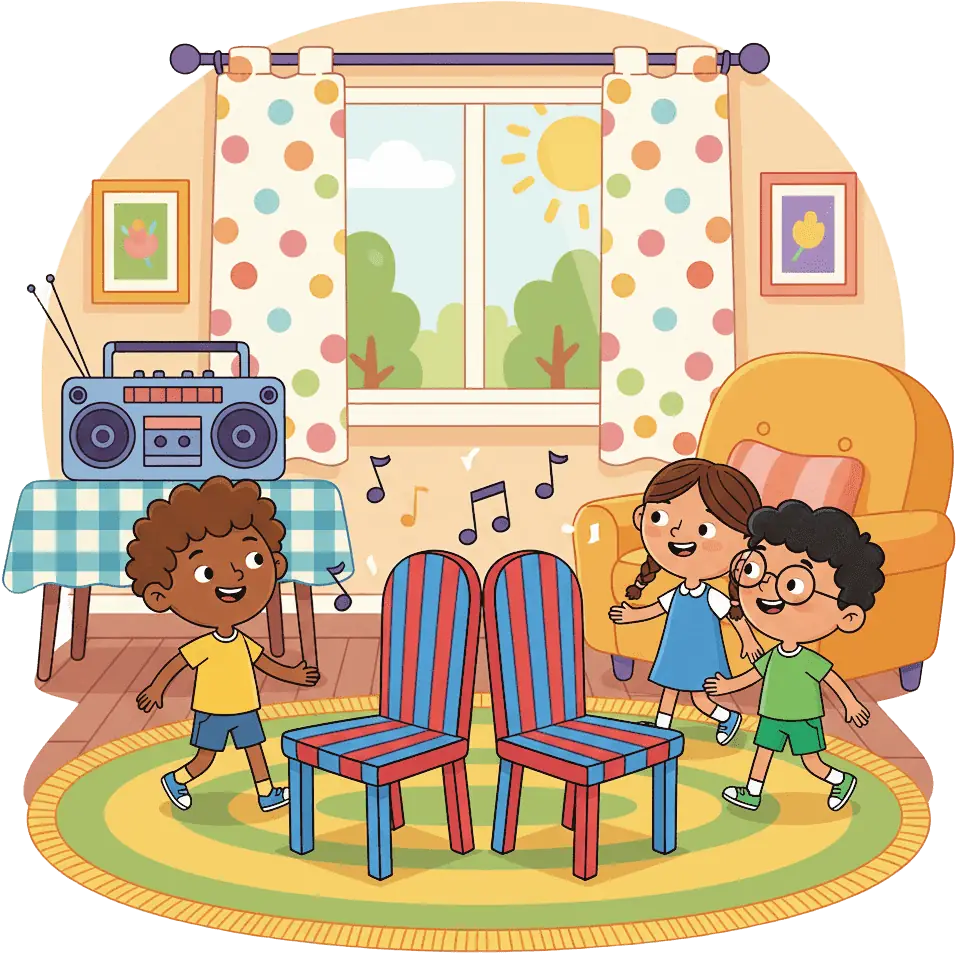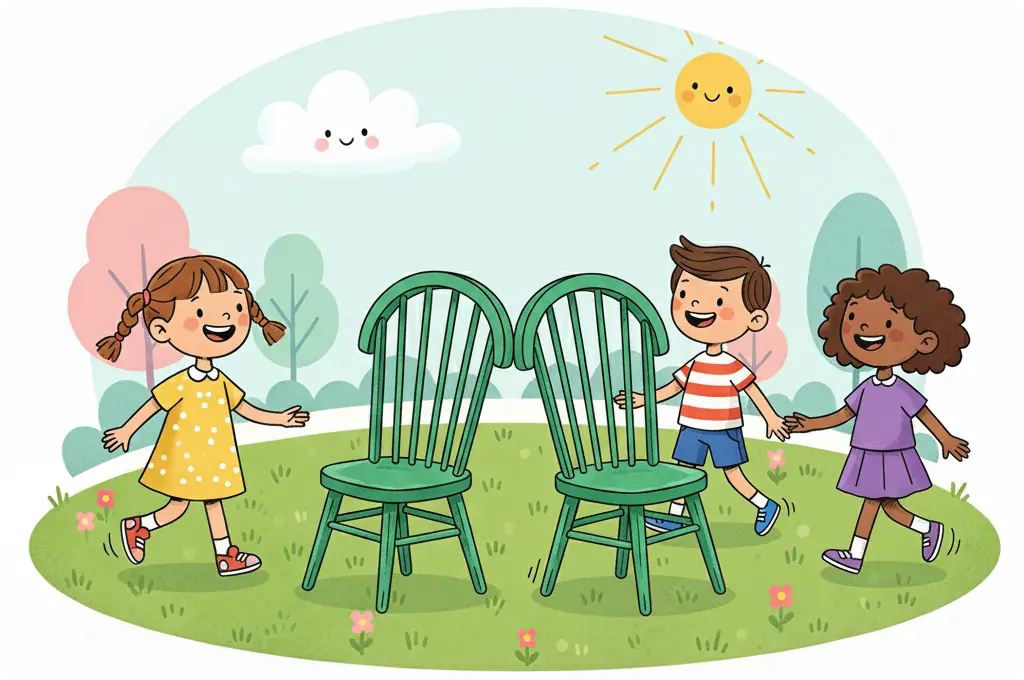The musical chairs game is a timeless party favorite that gets players laughing, moving, and competing to grab a seat when the music stops. If you’re searching for simple, energetic party games, the musical chairs game delivers fast rounds, easy setup, and universal appeal for kids and adults alike.
Table of Contents
- What is a Musical Chairs Game?
- How to Play the Musical Chairs Game: Step-by-Step Rules
- 1. Preparation: Gather Supplies and Players
- 2. Arrange the Chairs
- 3. Explain the Rules to Players
- 4. Start the Music and Begin the Round
- 5. Stop the Music and Sit
- 6. Remove a Chair and Reset for the Next Round
- 7. Repeat Until There’s a Winner
- 8. Quick Variations You Can Add (Optional)
- 9. Safety and Fairness Reminders
- Variations of the Musical Chairs Game
- Games Similar to Musical Chairs
- Setting Up Your Space for the Perfect Music Chair Game
- Recommended Playlists and Music Choices for Musical Chairs Game
- Safety and Fairness Tips for Hosting Party Games Musical Chairs
- Musical Chairs Game FAQ
- Musical Chairs Game Conclusion
What is a Musical Chairs Game?
At its core, the musical chairs game is a rhythm-based elimination activity where players circle a shrinking number of chairs while music plays. When the music stops, everyone scrambles to sit—anyone left standing is out. The last person seated wins. This music chair game is ideal for birthdays, school events, and casual gatherings.
How to Play the Musical Chairs Game: Step-by-Step Rules
The musical chairs game is fast, simple, and great for parties because everyone understands the goal instantly: find a seat when the music stops. Below is a clear, step-by-step breakdown you can follow the first time you host the game — or share with helpers so the rounds run smoothly and safely.
1. Preparation: Gather Supplies and Players
Before you start, take a few minutes to prepare the play area and materials. This ensures the game runs smoothly and keeps everyone safe and engaged from the first round.
- Count players and place chairs in a circle or staggered pattern.
- Use one fewer chair than players (for example, 10 players = 9 chairs).
- Choose sturdy, non-wheeled chairs or cushions for young children.
- Designate a music operator (or use a playlist and a randomized stop method).
- Clear the play area of hazards and mark the bounds so players know where to walk.
2. Arrange the Chairs
How you set up the chairs affects both safety and fun. A good layout gives players room to move while keeping the competition close.
- Position chairs back-to-back or in a loose ring so players can move around them easily.
- Space chairs so players can safely circle without bumping into furniture or walls.
- If outdoors, ensure the surface is level; weigh down lightweight chairs if wind is likely.
3. Explain the Rules to Players
Before the first round starts, explain the basic rules clearly so everyone understands what to do when the music starts and stops.
- Tell everyone to walk, dance, or march clockwise (or allow any direction) while the music plays.
- Explain that when the music stops, each player must try to sit on a chair as quickly as possible.
- Make clear the safety rules: no pushing, no climbing on chairs, and no blocking other players.
- Announce any tie-breaker rules (e.g., both players who reach the same chair step back and race again).
4. Start the Music and Begin the Round
Once the players are ready, the fun begins. The key is to keep the timing unpredictable so everyone stays alert and excited.
- Begin playing music with a clear beat.
- Players walk, dance, or move around the circle while the music plays.
- The music operator should vary the timing to keep the game unpredictable.
5. Stop the Music and Sit
This is the heart of the musical chairs game — the moment when tension rises and everyone rushes for a seat.
- When the operator stops the music, players rush to sit on the nearest available chair.
- Any player left standing is eliminated for that round.
- If two players reach the same chair, follow your pre-announced tie rule (e.g., a quick jump-back and sprint or a coin flip).
6. Remove a Chair and Reset for the Next Round
After each round, one chair is removed. This simple step keeps the excitement building as the game narrows toward a winner.
- After each elimination, remove one chair from the circle.
- Rearrange remaining chairs if needed so they form a clear path to circle again.
- Ask remaining players to resume moving once the music starts.
7. Repeat Until There’s a Winner
Keep the rounds going until there’s just one chair left — and one player seated on it. This final moment always brings cheers and laughter.
- Continue rounds of playing and stopping music, eliminating one player each time.
- When only one chair and two players remain, the last music stop determines the winner.
- Declare the final seated player the winner of the musical chairs game.
8. Quick Variations You Can Add (Optional)
Adding a creative twist keeps the game interesting for repeat players or different age groups. Try one or two of these fun ideas to mix things up.
- Team rounds: Pair players and require both to sit on the same chair.
- Freeze round: Stop music and freeze — last to freeze is out (gentler for younger kids).
- Challenge chair: Place cards under some chairs with dares or prizes for added fun.
9. Safety and Fairness Reminders
A few simple precautions make the game safe and enjoyable for everyone, especially when kids of different ages are playing together.
- Use an adult or impartial person as the music operator to avoid bias.
- Enforce no-pushing and no-tripping rules strictly.
- For mixed ages, give younger players a head start or use non-elimination consolation rounds.
This step-by-step layout makes the musical chairs game quick to teach and repeatable across ages and party types. Follow these steps once or twice, then let the rounds flow — the unpredictability of the music is what keeps the energy high.

Variations of the Musical Chairs Game
Classic musical chairs is only the beginning. Pair players and require partners to share a seat. For adults, add trivia or dares to chairs so the person who sits must complete the challenge. For toddlers, slow the music and use pillows instead of chairs. These variations keep the music chair game fresh and adaptable to any crowd.
Games Similar to Musical Chairs
If you love party games musical chairs, there are several alternatives that capture similar energy. Freeze dance freezes players when the music stops but eliminates no one; limbo tests flexibility beneath a bar (limbo game – sponsored link); and pass-the-parcel adds unwrapping layers of surprise. These games similar to musical chairs are great as follow-ups or station activities at larger parties.
Setting Up Your Space for the Perfect Music Chair Game
Choose an open, safe area with non-slip flooring. Use chairs without wheels and space them to allow easy movement. If outdoors, anchor lightweight chairs to prevent tipping. Test your music volume—loud enough to enjoy but not so loud that players can’t hear a stop signal. A good playlist with varied tempos will make each round feel different and keep the music chair game exciting.
Recommended Playlists and Music Choices for Musical Chairs Game
Pick songs with clear beats and predictable breaks for smooth start-and-stop fun. For children’s parties, upbeat pop and kid-friendly themes work well. For teen or adult parties, mix classics, dance hits, and novelty songs to surprise players. Changing tempo mid-round can add hilarious chaos to the music chair game and raise the stakes in each round.
Safety and Fairness Tips for Hosting Party Games Musical Chairs
Set ground rules to avoid pushing or tripping. Encourage gentle play and establish a clear tie-breaker rule if two players reach the same chair simultaneously. For mixed-age groups, consider using more forgiving elimination methods or team-based rounds. Fairness keeps the focus on fun, and safety adjustments let younger children enjoy the music chair game without risk.
Musical Chairs Game FAQ
What age is musical chairs game suitable for?
Musical chairs game works for nearly all ages with adjustments. Younger children need more space and softer seating like cushions; adults can enjoy faster rounds and tougher variations.
How many players do you need for a music chair game?
You can play with as few as three players, but musical chairs shines with larger groups—6 to 20 players is common for lively rounds.
Can you play musical chairs game without a music player?
Yes. Use a phone, speaker, or live musician. Alternatively, have an emcee clap or call out to start and stop the rounds when no recorded music is available.
What are some safe alternatives to musical chairs?
Games similar to musical chairs include freeze dance, pass-the-parcel, and musical statues—options that keep music and movement without the scramble for seating.
Musical Chairs Game Conclusion
The musical chairs game is a quick-to-learn, energetic addition to any party. With easy setup, countless variations, and simple safety tweaks, it’s one of the most flexible party games musical chairs hosts can rely on. Repeat the musical chairs game often to keep energy high. Try a few variations and playlist swaps to make the game new at every event.
For more game ideas for your party, see our Party Games section.

